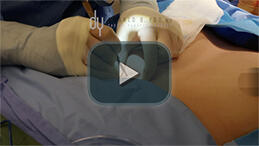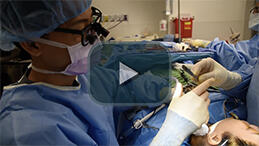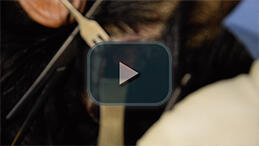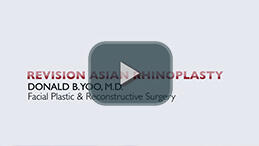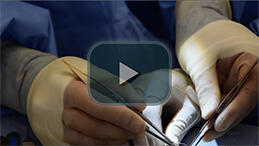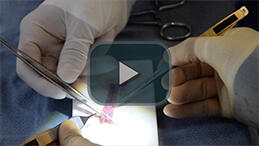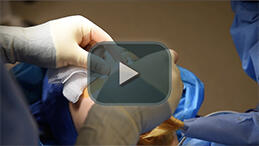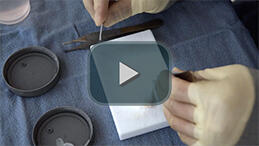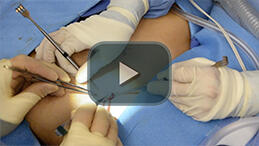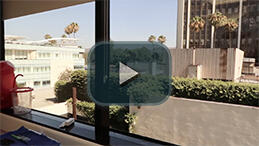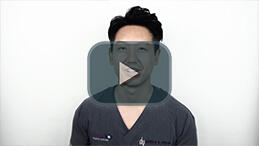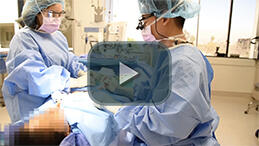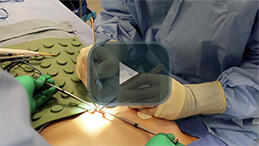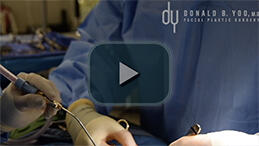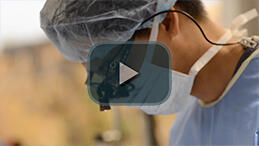SERVICES
Asian Rhinoplasty
The nose takes center stage on your face, and is often the first facial feature other people notice. It’s understandable that you might want to enhance its appearance or functionality. Rhinoplasty and Asian rhinoplasty procedures have become increasingly sought-after, driven by advancements in techniques that promise better cosmetic and functional outcomes. It’s important to consider how such changes can positively impact your confidence and overall well-being.
What is Asian Rhinoplasty?
Rhinoplasty is one of the oldest plastic surgery procedures, and Asian nose job surgery has made immense advances in recent times as surgeons have continued to make technical innovations such as using autologous grafts (tissue from your own body such as rib cartilage, temporalis fascia and diced cartilage fascia DCF) to create aesthetically superior Asian rhinoplasty results in a permanent manner.
Some rhinoplasty surgeons try to generalize Asian rhinoplasty to mean reshaping noses that are bulbous, short, wide and flat. However, in many ways this perspective is too simplistic and limited. As an esteemed Asian rhinoplasty specialist, Dr. Donald Yoo prefers to take a more personalized approach to Nasal Plastic Surgery, customizing each procedure for the individual patient. He recognizes the uniqueness of each patient and tailors every procedure accordingly, ensuring that the results align with their specific goals and characteristics, acknowledging the significance of each person’s journey towards self-confidence and self-expression.

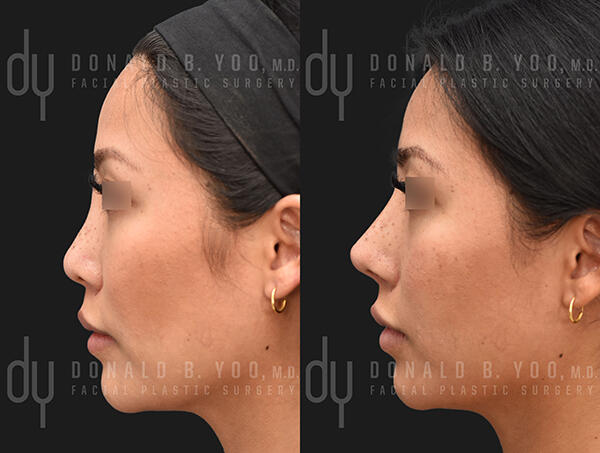
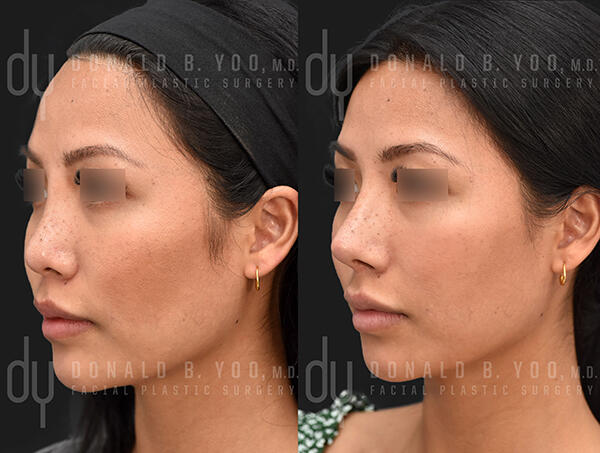
How is Asian Rhinoplasty different in terms of approach and procedure?
Asian rhinoplasty is unique, and requires not only special expertise but also a keen eye for Asian beauty.
A beautiful nose is not just tall and projected, but should look natural and balanced when viewed from
every angle. Some of the distinct characteristics of Asian noses are plain to see from the outside, while others extend far beyond the skin surface. The anatomy of the nasal framework and nasal bones often differ from other ethnicities, as well as the skin itself. Asians tend to have nasal skin that is thicker and more sebaceous, creating less definition in the tip of the nose. Each procedure is a journey towards enhancing self-confidence and embracing one's unique identity, requiring both technical expertise and a compassionate understanding of beauty in its diverse forms.
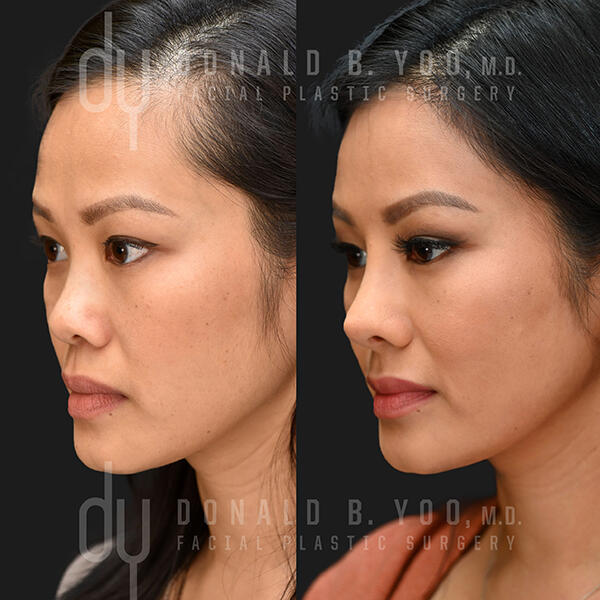
Nose tip shape, size and projection
The lower lateral cartilage, or tip cartilage, tends to be softer and less rigid than other ethnicities, and often is shorter in overall length. Tip shape, size and projection is determined by the intrinsic characteristics of the tip cartilage, and these characteristics many times result in a tip that may be bulbous, wide and under-projected. The nostrils may also appear to “flare” due to the convexity of these cartilages.
In comparison to other ethnicities, the lower lateral cartilage, also known as the tip cartilage, typically possesses a softer and less rigid quality and is often shorter in overall length. The shape, size, and projection of the tip are influenced by the inherent features of this cartilage, often leading to a bulbous, wide, and under-projected appearance. Additionally, the convexity of these cartilages can contribute to the perception of "flared" nostrils.
Nose Height
Dorsal height, or the height of the “bridge” of the nose is determined by the size, shape and orientation of the nasal bones, as well as the cartilage in the middle vault of the nose. In some Asians, the nasal bones have an oblique (more horizontal than vertical) orientation, and simply fracturing the nasal bones will not allow them to be narrowed sufficiently. In these cases, the dorsum must be augmented to allow better definition of the bridge, and create a more attractive profile and a more refined frontal view.
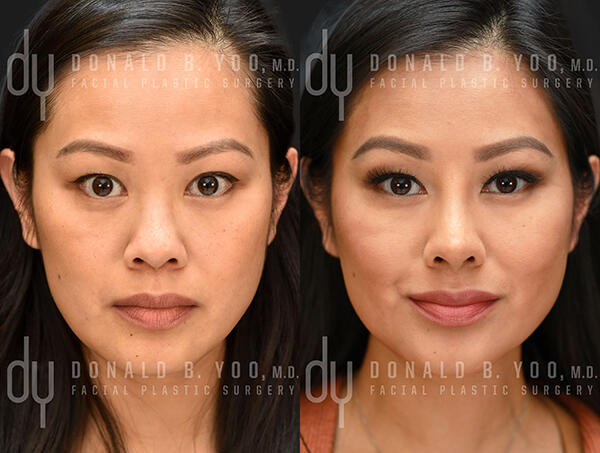
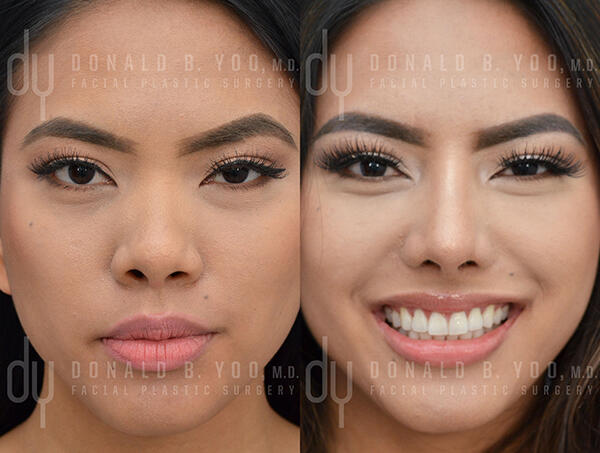
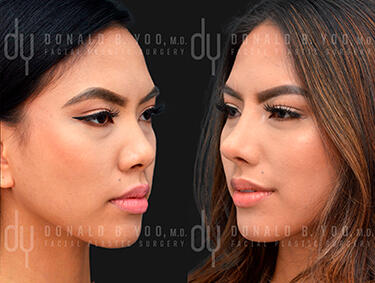
What type of implant should I get?
Silicone / Gore-tex vs. Autologous grafts
An important advancement in Asian Cosmetic Nose Surgery is the choice of material used to sculpt a nose that reflects beauty and harmony. In the past, artificial implants made of Silicone or Gore-tex were the most popular choice due to their ease of use, and the rapid familiarity surgeons could develop with them. Surgeries using Silicone or Gore-tex implants can be performed quickly, since there is no need to harvest or tailor grafts to the individual patient. However, synthetic implants do come with several distinct disadvantages compared to autologous grafts which are made from your own tissue.
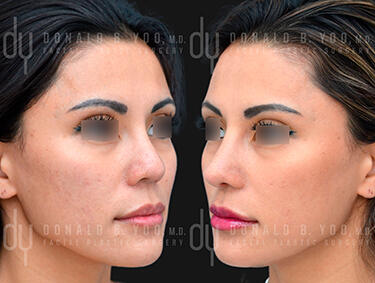
These disadvantages include:
- Infection
- Migration (movement)
- Extrusion (coming through the skin)
With a synthetic implant, such as Silicone or Gore-tex, the nose may look great initially – sometimes even 15-20 years. However, in the vast majority of patients the implant will need to be removed or revised at some point. Some have attempted to improve the safety of this old-fashioned technique by employing a synthetic implant in the bridge while using septal or ear cartilage grafts in the tip of the nose. A foreign body still remains in the nose, and the result continues to have a higher rate of complications than autologous grafts.
With autologous grafts, the result lasts a lifetime.
Homologous Implants
Besides synthetic implants, some surgeons have also used homologous implants (donated tissue from a cadaver). Cadaveric cartilage has a lower risk of complications than synthetic grafts, but generally have less predictable long term results than autologous grafts from your own body. Unlike autologous tissue, which is still viable and has living cells which become incorporated into your nose, homologous implants have been irradiated and do not have any living cells. This causes these implants to be more prone to resorption and loss of volume than autologous grafts which provide lifelong results.
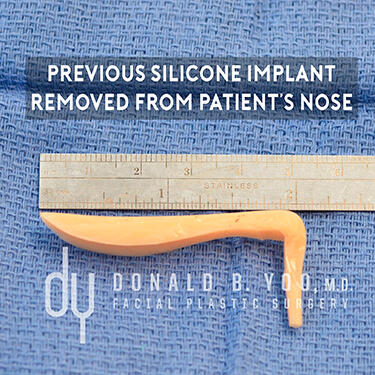
This patient had a previous silicone implant in her nose by another doctor. Dr. Yoo removed the synthetic implant and performed a revision rhinoplasty with Rib Cartilage and DCF
Dr. Yoo exclusively uses autologous grafts as they provide the most permanent, natural, and beautiful results in the safest manner. Employing state-of-the-art techniques, he is able to carefully harvest these grafts with hidden, minimal scars.
What are the available options for Autologous Grafts?
Dr. Yoo carefully selects the most suitable material for your nose, ensuring that each type serves a distinct purpose and application. The autologous graft materials he may utilize comprise:
1.
nasal septal cartilage
During your consultation, Dr. Yoo will perform a comprehensive external and intranasal examination of your nose. He will then sit down with you and create personalized computer imaging of your nose based on your aesthetic goals and determine which combination of surgical techniques and grafts will be necessary to achieve your ideal profile line and the most attractive nose for your face.
Not all surgeons are equally comfortable harvesting each of these grafts, and this is another reason pre-made Silicone and Gore-tex implants are so popular. Nasal septal cartilage is the cartilage between the nostrils, and a small portion can easily be removed without visible incisions to provide material for grafts. Ear cartilage is harvested through an incision hidden in the crease behind the ear, and does not change the size, shape or appearance of the ear.
Crafting Beauty with Precision
Expertise and specialized training are crucial for the safe and effective harvesting of rib cartilage. Dr. Yoo is amongst a small group of surgeons who routinely perform this procedure. Dr. Yoo harvests rib cartilage (~4 cm) from the 5th or 6th rib through a minimal incision (~1.0 cm) hidden in the infra-mammary crease (under the right breast/chest). Following healing, the appearance, contour and feel of the chest is just as it was before surgery, with the addition of a small scar.
Dr. Yoo will determine the most suitable autologous tissue for grafting based on your unique anatomy, and your aesthetic as well as functional goals.
The septum provides relatively straight, strong, cartilage and is a good source of creating grafts to project, support and refine the tip of the nose. In cases where dorsal augmentation is desired (building the bridge of the nose), and often during revision rhinoplasty, additional cartilage is usually required to achieve desired results. Ear cartilage, known for its softness and pliability, emerges as a gentle yet effective option for refining the tip and achieving subtle to moderate dorsal augmentation, catering to individual needs with care and consideration. For those seeking more significant transformations such as dramatic tip refinement, increased tip projection or dorsal, rib cartilage stands out as the preferred choice. Recognized for its strength and abundant volume, rib cartilage offers a solid foundation for achieving meaningful changes while ensuring patient comfort and confidence throughout the journey.
With care and consideration, fascia is delicately harvested through a discreet incision hidden within the hairline above the ear, ensuring minimal disruption to your natural appearance. There's no need for shaving or cutting any hair, preserving your aesthetic preferences and personal style.
After the procedure, the incision is carefully closed with surgical clips, which are typically removed after one week. Remarkably, many patients find that the area feels as though nothing has been done, as the incision seamlessly blends into the hairline, offering both physical and emotional comfort throughout the healing process.
A great benefit of autologous grafts is that within a few weeks after surgery, the grafts become fully incorporated into the nose – with its own blood supply and lymphatic drainage. It is as if you were born with it, because it is your very own tissue.
Benefit of an Alar Base Modification (Nostril Reduction)
Alar base modification, also known as nostril reduction surgery, is a technique used in rhinoplasty to adjust the width and flare of the nostrils, aiming to enhance facial harmony and balance. When there's excess flare, a Weir incision is thoughtfully crafted to remove a wedge of nostril tissue. Conversely, when excess width is an issue, a sill incision is skillfully designed to reduce the width of the nostrils.
It's important to maintain a delicate balance in the appearance of the nose, ensuring that the width of the base aligns with the distance between the inside corners of the eyes. Alar base modification may be considered when this balance is disrupted, and the base of the nose appears wider than this natural proportion.
When performed with care and precision, alar base modification can not only refine the appearance of the nose but also preserve its natural aesthetics, ultimately contributing to a more balanced and harmonious facial profile while preserving a natural appearance.
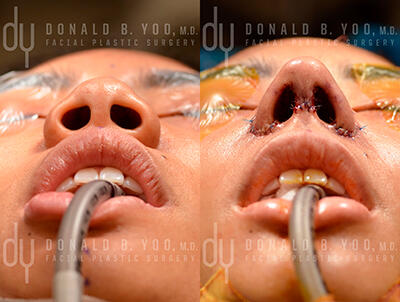
How much does Asian Rhinoplasty Cost?
The cost of Asian Rhinoplasty reflects the unique needs and circumstances of each individual, as it's influenced by factors such as the complexity of the surgery and the expected duration. It's essential to consider various aspects, including the patient’s existing nasal anatomy, any history of previous rhinoplasty procedures, functional concerns related to nasal airflow, and the desired aesthetic outcomes. Each of these elements contributes to the potential complexity of the surgery, and our team is dedicated to providing personalized care and support throughout the process.
During your consultation, Dr. Donald B. Yoo will work with you to create a surgical plan to achieve your desired aesthetic and functional goals. Based on this plan, our patient care coordinator will provide you with a quote that includes the Surgeon Fee + Facility Fee + Anesthesia Fee. All post-operative visits with Dr. Yoo are also included at no additional charge.
The total cost for Asian Rhinoplasty and Revision Rhinoplasty typically includes:
1) Anesthesia
2) Facility
3) Surgeon Fee
4) Pre-Operative Costs
5) Post-Operative Costs
Anesthesia
Dr. Yoo works only with the top board-certified (MD) anesthesiologists in Beverly Hills to provide you with the best general anesthesia, prioritizing your comfort and well-being throughout your nasal rhinoplasty surgery. The anesthesiologist will ensure you remain completely comfortable and asleep during the entire surgery, and wake up from surgery without nausea or pain. Most patients will wake up from Asian nose job surgery feeling like it was a short nap. Your comfort and peace of mind are our top priorities throughout your surgical journey.
Facility
Your Asian Rhinoplasty surgery will be performed in a fully accredited outpatient surgery center in the heart of Beverly Hills. Dr. Yoo works with his own team of registered nurses (RN) and certified surgical technologists (CST) dedicated to ensuring a safe and comfortable surgery experience for you. After your surgery you will recover in the recovery room (typically 1-2 hours), and then may return home or to a local hotel.
Surgeon Fee
Dr. Donald B. Yoo is an internationally renowned expert in Asian nose job surgery. As a leader in natural surgical techniques utilizing tissue from a patient’s own body, he has published and lectured internationally on his specialized techniques and unique approach for achieving aesthetically balanced and naturally beautiful outcomes of nasal aesthetics. He has innovated the most advanced Asian rhinoplasty techniques, including: rib cartilage harvesting techniques through the smallest and most minimal incision (0.8 – 1.0 cm) available today to minimize discomfort and accelerate rapid recovery; tip refining techniques to create a beautiful, defined appearance while improving airway function; dorsal augmentation with unique updates to the diced cartilage fascia (DCF) technique to maximize precision, longevity and dorsal aesthetic results.
Autologous graft techniques (tissue from your own body) with many individualized, custom grafts during nasal reconstruction does create greater complexity and technical challenge for the surgeon, with resultant longer surgery times than using a single en bloc rib cartilage, cartilage from a cadaver, or synthetic materials.
When it comes to choosing an Asian rhinoplasty surgeon, once she/he meets the qualifications of proper training and experience, the most important determinant is your comfort level that the surgeon is1) technically capable of achieving your goals2) aesthetically on the same page with your ideals
Pre-Operative Costs
To make certain you are a safe candidate for surgery, we do require routine medical tests (blood work and an electrocardiogram) and medical clearance prior to surgery. These may be obtained from the primary care provider of your choosing, and our office will coordinate with your provider’s office to request the appropriate tests. Dr. Yoo will prescribe a number of medications to optimize your surgical recovery, and these should be filled prior to surgery. The costs of the medical tests and prescriptions are the patient’s responsibility, and in some cases may be covered by insurance.
Post-Operative Costs
Our office will provide a post-operative bag including all of the essentials to get you started on the road to recovery. The bag includes:
- gauze sponges
- sterile Q-tips
- eyemask for cold and hot compresses
- nasal tape
- peroxide
- antibiotic ointment (Bacitracin)
- Aquaphor
- scar gel (Skinuva)
- saline rinses (Sinurinse)
- medicine cups
The post-operative bag will be provided to you free of charge prior to surgery. After Asian nose job surgery, you will need to follow up closely with Dr. Donald B. Yoo to ensure optimal healing, and this includes follow-up visits 1 day, 1 week, 2 weeks, 4 weeks, 2 months, 6 months, 1 year and 2 years after surgery. All post-operative visits with Dr. Yoo are also free of charge.
Financing is available through CareCredit
Frequently Asked Questions
Q&A
with Dr. Donald B. Yoo, M.D., F.A.C.S
How much is an Asian Rhinoplasty / Asian Nose Job?
Pricing for Asian Rhinoplasty will depend on a few key factors, including primarily the experience-level and esteem of the Asian rhinoplasty surgeon, the complexity of your specific case (as it relates to your baseline nasal anatomy as well as previous surgical history), and the geographic location of the surgeon’s practice.
What is an Asian Nose Job?
Asian Nose Job is a general term for rhinoplasty or nose reshaping surgery for patients of Asian descent, including but not limited to: Korean, Chinese, Japanese, Vietnamese, Filipino/Filipina, Indonesian, Hmong, Laotian, Cambodian, Maylasian, etc. During Asian nose job surgery the commonalities of dorsal augmentation (increasing height of the bridge of the nose) and increasing nasal tip projection and refinement, while adding overall definition to the nose often exist. While many different techniques exist to address these shared attributes, using tissue from your own body (rib cartilage with diced cartilage and fascia, or ear cartilage with septal cartilage) will create the best aesthetic and functional result.
Are nose jobs safe?
As with any surgery, nose job and rhinoplasty surgery does come with its share of risks. Chief amongst these risk is the risk of not loving your surgical result, which in the case of rhinoplasty is an astonishingly high 17-20% in the United States on average. This makes it critically important to do your due diligence as a patient, by seeking out experienced and qualified surgeons who have many previous patients with your characteristics, and before and after photos and videos demonstrating proficiency in performing the exact surgery you seek in those similar patients.
Do nose jobs last forever?
When only tissue from your own body is used (septal cartilage, ear cartilage, rib cartilage, fascia) during rhinoplasty or nose job surgery, the result is permanent. This is not to say that the nose will be frozen in time and remain constant in appearance. The nose will continue to undergo age-related changes (a common change is that the tip of the nose will drop slightly each year due to the effect of gravity, whether an individual has surgery or not). Depending on the surgical techniques used, the nose may retain greater strength than the previous unoperated nose, and may be more resistant to age-related changes.
How painful is a nose job?
Typically a nose job or rhinoplasty surgery is not painful, and the most uncomfortable part of recovery is the inability to breathe fully through the nose. Most surgeons will use some type of compression inside the nose during recovery to reduce swelling inside the nose which will cause some reduction in nasal airflow. By the end of the week, breathing should return to normal.
In the case of rib cartilage harvest during rhinoplasty, when performed through a minimal incision with precise dissection around the rib, discomfort will feel like a sore ab muscle (rectus abdominus) for the first 3-5 days. Exercise may resume at 2 weeks after surgery.
Who is a good candidate for a nose job?
Though many factors come into play when determining appropriate candidacy for a nose job, the paramount factor is the patient’s expectations. The goal for surgery should always be improvement not perfection. With the right surgeon, and with clear communication, this will almost always be achieved. Patients who are looking to a nose job or rhinoplasty to alter the course of their lives or bring happiness to their life through surgery, are often not good candidates.
Does a nose job change your smile?
Depending on the way the shape and structure of the nose is altered during surgery, the smile may also change. This can often be anticipated by your surgeon prior to surgery, and the surgical plan adjusted to reflect your personal preferences.
Can a nose job change your voice?
Typically a nose job will not change the core qualities of your voice. However, if there is a significant cause of nasal obstruction, and that obstruction is addressed during your nose job surgery, then the increased air flow may have a mild effect on your tone.
Do they break your nose during rhinoplasty?
When the nasal bones are too wide, deviated or asymmetric in orientation, they may be fractured or “broken” to reposition them. Though this may contribute to bruising after surgery, it typically is not a source of pain during recovery.
Can a bad nose job be fixed?
Most nose jobs, even a bad or “botched” rhinoplasty, can often be improved. The degree of improvement will depend on the pre-existing anatomy, the presence of scar tissue, the health of the vascular supply and the skill level of the revision rhinoplasty surgeon.
Why do you use rib cartilage during Asian Rhinoplasty?
For patients desiring a mild to moderate degree of augmentation and change, cartilage from the nose (septum) or cartilage from the ear (conchal) may be sufficient to create the desired appearance. Often in Asian patients, septal cartilage and cartilage from the ear may be weak and flimsy. Consequently, for patients with thicker skin, softer nasal cartilage, and for patients seeking a more significant degree of change, often greater structure and support is necessary – in the form of rib cartilage.
Rib cartilage is permanent, as it is from your own body, and depending on the surgeon’s finesse, may create a structurally strong yet aesthetically delicate and refined nose.
Do I have to be Asian to undergo Asian Rhinoplasty?
The term Asian Rhinoplasty is a broad, descriptive term that describes a common set of anatomical traits and a group of surgical techniques used to address them. While in the strictest sense, it does apply to Asians undergoing rhinoplasty, in a more general sense it is possible for patients from any ethnicity to have the characteristics shared by individuals seeking Asian nose job surgery – namely, greater augmentation of the nasal dorsum, projection of the nasal tip, and increased definition and refinement of the nose.
Can Rib Cartilage Grow Back After Being Harvested?
While a small portion of the costal cartilage may regrow if the edges of the perichondrium covering it are re-approximated, it will be different in shape and appearance than the cartilage that was removed. Nonetheless, after rib cartilage harvest the only difference you will be able to notice or feel between the left and right is the presence of a small, thin scar.
What are the risks of using DCF (Diced Cartilage Fascia)?
The diced cartilage fascia technique does require special expertise and a great deal of experienced to create consistent, predictable results. The most commonly encountered issue is contour irregularities and asymmetries – as with any technique for dorsal augmentation. In skilled hands, the diced cartilage fascia technique provides permanent, natural and attractive results, but in inexperienced hands can be unpredictable and inconsistent.
Will my rib cartilage become weaker after rib harvest during Asian rhinoplasty?
A small portion of the cartilaginous portion of the rib is taken (for my patients, usually ~4 cm from the right 6th rib). You will not have any untoward effects in terms of health or function, as it only a small portion of the 12 ribs on each side of the body, and the rib cage will continue to function to protect the vital organs and provide structure to the chest in exactly the same manner. Rib cartilage harvest is well tolerated even in my patients who are professional boxers and mixed-martial artists. The biggest downside to have rib cartilage harvested is a thin ~1 cm scar, which will be present in the crease under your right breast or pectoral.
What kind of nose surgery do I need to make my nostrils (or sides of my nose) smaller?
Alar base modification is an effective way to reduce the flare and/or width of the nostrils. Excess width can be reduced with sill incisions, excess flare with Weir incisions, and excess flare + width addressed with a combined Weir+sill incision. The most appropriate type of Alar base modification for your Asian nose job surgery will be determined during your consultation with Dr. Donald B. Yoo and will be based on the confluence of your existing anatomy with your aesthetic goals.
What should I do if my pre-existing silicone implant is displaced from a previous surgery?
Silicone implants can become “displaced” or “migrate”, meaning they can move. The possible danger to your health would be from the risk of extrusion (of the implant thinning your skin to the point of ulcerating through) and the risk of infection. Signs that this is occurring include redness and tenderness along the nose where the implant is. Unless either of these is happening, your health is not at imminent risk, though at some point the implant will have to be removed.
When an silicone or Goretex implant has been placed in the nose, it may be removed and replaced with your own cartilage simultaneously during revision Asian rhinoplasty as long as there is no active infection, and the skin is completely intact.
Increased Swelling 4 Months After Asian Rhinoplasty – Should I be worried?
For an entire 1-2 years after your surgery, your nose is continuing to heal and take on its final appearance. For most patients, the resolution of swelling follows a sinusoidal curve rather than a linear pattern, meaning some days and weeks the swelling will be even more than the ones directly preceding them.
During the first year of healing, it’s not unusual to see your nose fluctuate in size and the in the amount of swelling, but the gradual trend will be towards reduction of edema. Following up closely with Dr. Yoo is important, as in some cases (especially with sebaceous skin and in patients with thicker skin) swelling may remain prolonged, and may benefit from injections of Kenalog and 5-Fluourouracil to expedite its resolution.
Why is irradiated rib cartilage in Asian Rhinoplasty sometimes not recommended?
The main downside with irradiated rib cartilage is the fact that it is dead tissue and not living, viable cartilage as from your own rib. This means that it will not become a living part of your nose, but rather will be placed by fibrotic tissue that will eventually resorb. For permanent results, your own cartilage (autologous grafts) is superior to any homologous grafts.
Diced cartilage fascia provides permanent results without the risk of warping or resorption of en bloc rib cartilage, and with a much lower rate of migration, infection, or extrusion than synthetic grafts.
How long should an out of town patient stay in the area after Asian nose job surgery?
For my out of town/out of country patients my preference is a 2 week stay in Beverly Hills/Los Angeles, with a 1 week stay being the minimum stay. The highest risk of infection is between 1-2 weeks after surgery while the nose is early in its healing stages. Sutures and a cast will be on your nose for a week, at which time my patients may fly home if they wish, but the incision lines will still have dissolvable sutures and remain a little raw until ~2 weeks after surgery.
At 2 weeks after surgery the incision lines will be nearly healed, and makeup can be applied to the nose. This is the point that most patients feel comfortable going back to their daily routine, and feel comfortable going back to work. With autologous grafts (rib grafts) the risk of infection is much lower than synthetic grafts, and after the nose is healed there is no increased risk of infection over your natural nose.
Dr. Yoo looks forward to helping achieve a more beautiful you.
Call now for your consultation: 310-772-0766
Asian Rhinoplasty Before & After Gallery
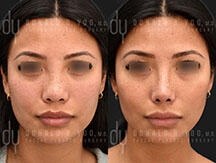
Before and after nasal augmentation with rib cartilage and DCF to reduce a bulbous nasal tip, reduce alar and nostril flare, and to create a more defined and augmented dorsum and nasal tip. Rib cartilage in the form of extended spreader graft, septal extension graft, alar rim grafts, shield graft, tip graft, and diced cartilage fascia graft were used to create a more structured and sculpted nose.
VIEW MORE PHOTOS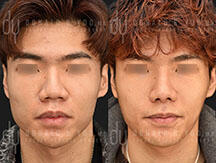
Before and after male Asian rhinoplasty with rib cartilage, DCF (diced cartilage fascia) and alar base modification to reduce the width and flare of the nostrils, slim and refine the nasal tip, and augment the nasal dorsum.
VIEW MORE PHOTOS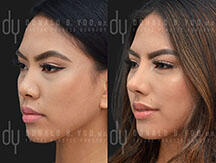
Before and after nose reshaping with rib cartilage, DCF (diced cartilage fascia) and alar base modification to create narrowing of the nostrils, slimming of the bridge of the nose, and to add definition to the tip of the nose. Nostril narrowing is achieved by projecting the tip of the nose with rib cartilage grafts while simultaneously straightening the shape of the nostril with alar rim grafts and reducing extra width and flare by removing a wedge of excess skin and tissue with a scar hidden in the crease between the nostrils and the cheeks.
VIEW MORE PHOTOS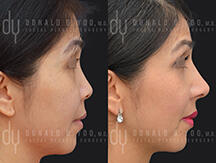
Before and after Asian rhinoplasty with rib cartilage and DCF (diced cartilage fascia) with extended spreader grafts, septal extension graft, alar rim grafts, shield graft, tip graft, and diced cartilage fascia to create dorsal augmentation, tip projection, nostril slimming and a more defined nose.
VIEW MORE PHOTOS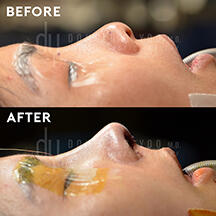
Asian nose job before and after using rib cartilage and DCF (diced cartilage fascia) with extended spreader grafts, tip graft, septal extension graft, shield graft, alar rim grafts and diced cartilage fascia to create tip projection, dorsal augmentation, nostril slimming and a more defined nose.
VIEW MORE PHOTOS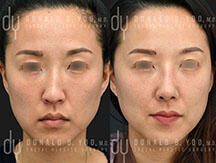
Before and after Asian nose surgery with rib cartilage and DCF with dorsal hump reduction, septoplasty to improve breathing, osteotomies to create greater symmetry, extended spreader grafts, septal extension graft, alar rim grafts, shield graft, tip graft and diced cartilage fascia to create a more symmetric and refined nasal appearance.
VIEW MORE PHOTOS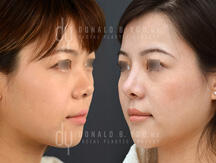
Asian rhinoplasty surgical procedure (before and after) with rib cartilage and diced cartilage fascia (DCF). This procedure lengthened and refined the nose. For the tip of the nose, a combination of extended spreader grafts, a septal extension graft, and tip refining grafts were used to transform and distinguish it. A diced cartilage fascia (DCF) graft was used to augment the bridge of the nose.
VIEW MORE PHOTOS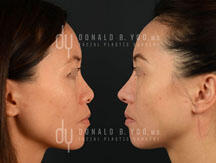
Primary Asian rhinoplasty (before and after). The patient underwent rib cartilage harvest, diced cartilage fascia (DCF) for dorsal augmentation, and alar base reduction.
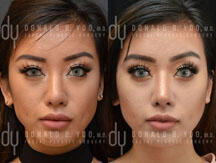
Revision Asian Rhinoplasty procedure with rib cartilage and DCF (diced cartilage fascia). A diced cartilage fascia (DCF) graft was used to achieve subtle augmentation of the bridge to create a straighter and more refined profile while the tip was projected and refined to create a smaller, more defined nasal appearance. (Before and After)
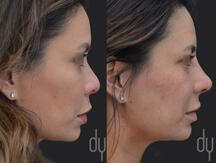
Before and after surgical Asian Nasal Cosmetic Procedure with rib cartilage and diced cartilage fascia (DCF) to lengthen and refine the nose. Extended spreader grafts, a septal extension graft, and tip refining grafts were used to project and reshape the patient's tip. A diced cartilage fascia (DCF) graft was used to augment the nasal bridge. These pictures were taken at 1 month post op.
VIEW MORE PHOTOS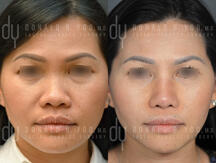
This before and after shows a surgical Asian rhinoplasty with rib cartilage and diced cartilage fascia (DCF) for lengthening and refining the nose. Alar base reduction was performed to reduce the size of the nostrils. To project and reshape the patient’s tip of the nose, extended spreader grafts, a septal extension graft, and tip refining grafts were used. A diced cartilage fascia (DCF) graft was used to enhance the dorsum. These pictures were taken at 4 month post op.
VIEW MORE PHOTOS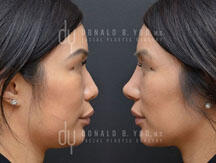
Revision Asian Rhinoplasty (before and after) with rib cartilage and DCF (diced cartilage fascia). A diced cartilage fascia (DCF) graft was used to achieve subtle augmentation of the bridge to create a straighter and more refined profile while the nose tip was projected and refined to create a smaller, more defined nasal appearance.
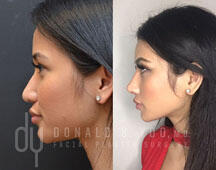
Revision Asian Rhinoplasty with rib cartilage and DCF (diced cartilage fascia). A diced cartilage fascia (DCF) graft was used to achieve greater augmentation of the bridge to create a straighter and more refined profile while the tip was projected and refined to create a smaller, more defined nasal appearance. (Before and After)
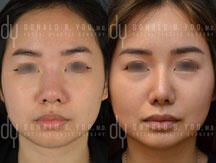
Before and After primary Asian rhinoplasty. The patient underwent rib cartilage harvest, diced cartilage fascia (DCF) for dorsal augmentation, and alar base reduction.
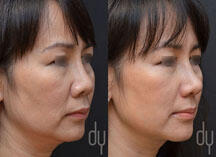
Photos of a before and after showing a Revision Asian Rhinoplasty with rib cartilage and DCF (diced cartilage fascia). The patient underwent rhinoplasty with another surgeon using a synthetic implant which gave her nose a very unnatural appearance. A diced cartilage fascia (DCF) graft was used to achieve subtle augmentation of the bridge to create a straighter and more refined profile while the tip was projected and refined to create a smaller, more defined nasal appearance.
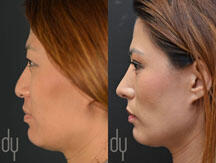
Asian cosmetic nose procedure, with rib cartilage and diced cartilage fascia (DCF), to extend and enhance the nose. A septal extension graft, extended spreader grafts and tip refining grafts were used to project and reshape the nose tip. To augment the dorsum, a diced cartilage fascia (DCF) graft was used. (Before and After)
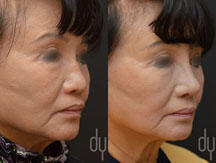
Before and after photo of a Revision Asian Rhinoplasty with rib cartilage and DCF (diced cartilage fascia). The patient underwent rhinoplasty with another surgeon using a synthetic implant, and developed bumpy calcifications while also thinning the skin and giving the nose a very unnatural appearance. A diced cartilage fascia (DCF) graft was used to achieve subtle augmentation of the bridge to create a straighter and more refined profile while the tip was projected and refined to create a smaller, more defined nasal appearance.
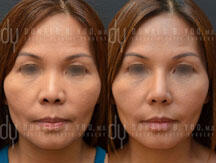
Surgical Asian rhinoplasty with rib cartilage and diced cartilage fascia (DCF) procedure used to lengthen and enhance the nose (before and after). Extended spreader grafts, tip refining grafts and a septal extension graft were used to project and refashion the nose tip. To augment the dorsum, a diced cartilage fascia (DCF) graft was used.
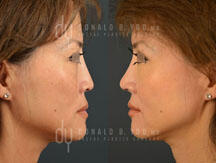
This procedure is a revision Asian rhinoplasty to improve the balance and harmony of this patient's facial features (before and after). This patient underwent rhinoplasty with another surgeon who used silicone to augment the bridge of her nose and her septal cartilage to refine the tip of her nose. This resulted in a bridge which was entirely too high relative to the proportions of her face, and a tip which was short and under-projected creating a flat appearance. The proper balance was re-established with her own tissue. Extended spreader grafts, a septal extension graft, and tip refining grafts were used to project and fine tune the patient's nasal tip. A diced cartilage fascia (DCF) graft was used to augment the nasal dorsum.
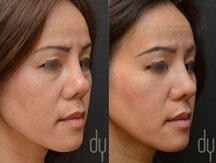
In this Revision Asian Rhinoplasty with rib cartilage and DCF (diced cartilage fascia), the patient underwent rhinoplasty with another surgeon using a synthetic implant, and developed an unnatural appearance with a significantly over-rotated tip and columellar retraction. The nose was lengthened, the tip counter-rotated and appropriate columellar show restored with revision Asian rhinoplasty using rib cartilage and diced cartilage fascia (DCF). (Before and After)
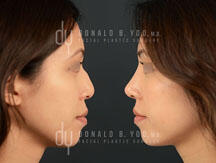
To achieve subtle augmentation of the nose bridge to create a straighter and more refined profile while the nose tip was projected and refined to create a smaller, more defined nasal appearance, an Asian Rhinoplasty with diced cartilage fascia (DCF) graft was used. The same hidden incision behind her ear was used to harvest ear cartilage and fascia for the DCF graft.
VIEW MORE PHOTOS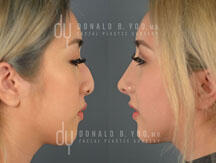
Before and After of an Asian Cosmetic Nose Reshaping with rib cartilage and DCF (diced cartilage fascia). A diced cartilage fascia (DCF) graft was used to achieve subtle augmentation of the nose bridge to create a straighter and more refined profile while the tip of the nose was projected and refined to create a smaller, more defined nasal appearance.
VIEW MORE PHOTOS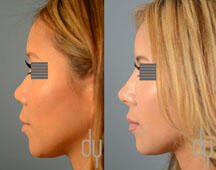
In this before and after, a surgical Asian rhinoplasty with rib cartilage and diced cartilage fascia (DCF) was used to extend and enhance the nose. Extended spreader grafts, a septal extension graft, and tip refining grafts were used to project and transform the patient's nose tip. Alar base modification was performed to slightly narrow and refine the nostrils. A diced cartilage fascia (DCF) graft was used to augment the nose bridge.
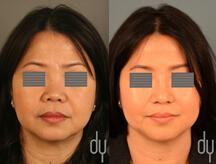
Asian nose job Before and After. The patient’s nose was augmented,lengthened and refined. This is an Asian rhinoplasty procedure with rib cartilage harvest and diced cartilage fascia (DCF).
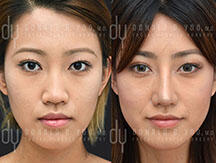
Before and after Asian nose job (rhinoplasty) with rib cartilage (costal), DCF (diced cartilage fascia) with extended spreader grafts, septal extension graft, shield graft, tip graft, alar rim grafts and diced cartilage fascia graft to create a more projected and defined nose.
Asian Nose Job Videos
To speak to a specialist directly: 310-772-0766
Patient Testimonials
Dr. Yoo is very professional in every way. He is very kind, generous, and willing to accommodate all of his patient’s needs. I even got him to dance on a Tiktok video.
My dream was to improve the appearance of my nose by getting my nostril size reduced and getting a higher nose bridge with a perfect tip that would go with the rest of my facial features. I addressed these concerns with Dr. Yoo and did a great job.
I believe Dr. Yoo is the best Asian nose doctor in the United States. To get any better (if even possible) would require traveling to Japan or Korea, and even then, you might end with a better result.
It has been six months since my operation (see the attached pictures for your reference). I could not be more excited to wake up in the morning and see the image that Dr. Yoo created. Let me end this by saying no doctor is not perfect, but Dr. Yoo is as close to it as you can get. He truly has hands that work miracles.
Thank you, Dr. Yoo.
Dr. Yoo is amazing at what he does! I came in for a non surgical rhinoplasty. I really want him to do my permanent rhinoplasty but cannot at this current moment. He’s the best I’ve seen with Asian ethnic noses and I intend on returning to have the actual surgery done the next time I see him! The result of my non surgical rhinoplasty is amazing! I now have height and balance to my nose. His work really is an art. Aside from his stunning work, he and his staff are the BEST! Dr Yoo is genuinely kind and the staff really looked out for me when they didn’t have to. I was scheduled to fly in from the Bay Area but Southwest canceled my flight 1.5 hours before departure! Even though I was dreading driving to LA, I was willing to make the drive. I ended up booking another flight ASAP because they were very understanding and worked with me on the timing. I am SO grateful for that. I’ve never had anyone do that for me before. I wanted to cry because I was so grateful and I’m sensitive. Lol. I would definitely recommend anyone that is inquiring to look no further. This is the best that it gets!
I have always wanted to get my nose done but at the same time worried that if I get surgery that it might look too unnatural or “screaming I had rhinoplasty look” lol. Until one day I saw Dr. Yoo’s page while browsing Instagram for asian rhinoplasty. Right away I knew that if I’m ever gonna decide to get my nose done that he’ll be the best doctor. I was impressed looking at post surgery pics how natural they all looked. Fast forward 7 months post rhinoplasty, I’m so happy with my decision. The only regret I had is that I didn’t find Dr Yoo sooner. Also, the staff during surgery were all great too! Best decision ever!
In December 2019, I had a revision rhinoplasty and lower blepharoplasty with Dr. Donald Yoo. I just had my 1.5 year follow up appointment and could not be more pleased with the final results! His skills are exceptional. As a matter of fact, I was very happy with the results even as early as week two post-op (understanding there is some normal swelling following a surgical procedure.)
I highly recommend him for his skill, artistry, and attention to detail, as well as his post follow up. Also, he has a wonderful staff and you can tell they love what they do- helping patients become their “best selves”!
You cannot ask for a better surgeon than Dr. Yoo!
I have wanted to have rhinoplasty done since I was very young, and when I was able to afford it I began my search for the best Asian rhinoplasty surgeon in the country. As a professional myself, it was important for my surgeon to have an impressive resume on top of before and after photos that met my standards. Dr. Yoo is the best of the best, and I love that he specializes exclusively on the face. I was not looking to go to a “one stop shop”, as I have heard horror stories from colleagues and friends. From the consultations to the surgical center, the whole experience was incredible. Due to COVID, my mom could not be with me for my first operation, so I had a friend join me on my journey from NYC to Califonia. Dr. Yoo’s staff made me feel safe throughout the entire journey and I love how often they checked in to make sure I was ok. I had rhinoplasty, alar base modification, and buccal fat removal performed and can confirm that you get what you pay for with this surgeon.
I have always wanted a nose job but was always so skeptical since I hadn’t found a doctor I could fully trust. I found Dr. Yoo’s Instagram one day and decided there was no better doctor out there. His entire Instagram is full of before and afters and they all look amazing! Most doctors only post a few before and afters and that just wasn’t enough for me to trust them.
Throughout the entire process, Dr. Yoo was so kind, willing to answer questions, patient, and very down to earth. His bedside manner is everything you want in a doctor. And the same goes for his staff! Surgery day was a breeze for me! He is so detail oriented and strives for perfection and I never once felt worried or nervous about the procedure. I would highly recommend him to anyone! He’s worth every penny! I can't thank him and his staff enough!
Latest News / Updates
November 14, 2025
One of the biggest challenges in Asian rhinoplasty surgery is creating dorsal augmentation and increased projection to the bridge of the nose in a way that is permanent, natural in feel and appearance, and aesthetically pleasing. Rhinoplasty surgeons have used … Continue reading
November 4, 2025
The contemporary landscape of Asian rhinoplasty involves advanced structural and contour grafting coming from an autologous source – meaning from the patient’s own body. Rudimentary techniques using synthetic implants like silicone, Medpor and Goretex are gradually being discarded as more … Continue reading
August 26, 2025
A very common question asked by man patients undergoing revision rhinoplasty, Asian rhinoplasty and ethnic rhinoplasty as these are the types of nose job surgeries frequently necessitating the use of cartilage in addition to what is available in the nose. … Continue reading
May 21, 2025
Rhinoplasty encompasses a broad range of techniques to reshape the nose. For patients with too much height, width or volume to the nose, often rhinoplasty may be performed by removing excess cartilage and bone from the nose to create a … Continue reading
October 14, 2024
Counter to what you may have thought, the best candidates for Asian rhinoplasty are not always Asian. Asian rhinoplasty refers to a subset of nose job surgery that addresses a common array of anatomic characteristics that are common, but not … Continue reading
July 30, 2024
Revision rhinoplasty surgery presents some specific challenges to the plastic surgeon in addition to the inherent challenges of nose job surgery. Trauma of any kind, including surgical trauma, creates a degree of injury with resultant inflammation and tissue remodeling. Even … Continue reading
Dr. Yoo looks forward to helping achieve a more beautiful you.
Call now for your consultation: 310-772-0766
Content
- What is Asian Rhinoplasty?
- How is Asian Rhinoplasty different in terms of approach and procedure?
- What type of implant should I get?
- What are the available options for autologous grafts?
- Crafting Beauty with Precision
- Benefit of an Alar Base Modification (Nostril Reduction)
- How much does Asian Rhinoplasty cost?
- Frequently Asked Questions
- Before and After Gallery
- Videos
- Testimonials
- Latest News
- Consultation

